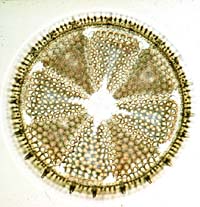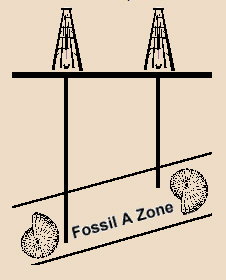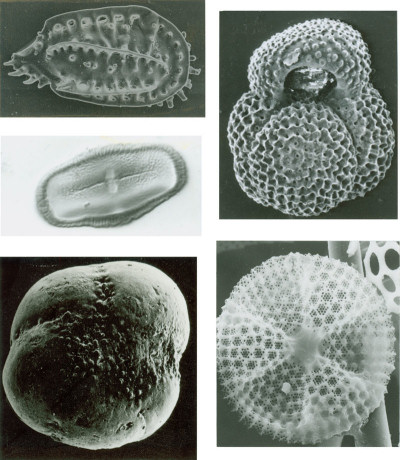Biostratigraphic Correlation
Correlating formations and zones from well-to-well is what the petroleum geologist specializes in. He will use well logs for correlation, if they are available. When the well is first drilled, he obviously has no well logs, so zones may be correlated with sample descriptions. But even sample descriptions may not work.
In certain areas, the well samples that are returned to the surface from the drill bit do not consist of various alternating beds of shale, limestone and sandstone. This makes it hard to correlate with well samples. The offshore Texas Gulf Coast is one of these places.
Instead of rocks that are fairly easy for the petroleum geologist to identify and sort out, the hole may be drilled through thousands and thousands of feet of rocks that are made up mostly of shale. This makes it very hard for the petroleum geologist to tell exactly what rock layers are being drilled, since most shale looks like most other shale. It also makes it difficult to tell the age of the rocks being penetrated. If the geologist is looking for the Mississippian formation, it may be difficult to find with standard mud-logging techniques.
Even with electric logs, it is very difficult to separate large intervals of shale into smaller parts. This makes correlation very difficult. Correlation is the process of inferring the rock layers in a location with little data to those from a known spot, where the zones have been clearly identified.
Correlating Rocks Between Oil and Gas Wells With Microfossils

A Microfossil Called a Diatom
But, the petroleum geologist has an answer for this! In these difficult areas, the rocks are identified by the tiny microfossils they contain. These microfossils are the skeletons of the tiny animals or plants that have lived in the ocean for millions of years. Eventually, they died, and were buried in the shale on the ocean floor. Some of these animals changed and evolved very quickly through time, and petroleum geologists have learned to identify rock layers by looking at the types and variety of microfossils contained in them. For example, some type of microfossil may be restricted to a tiny part of the Jurassic time period. Seeing the microfossil at a certain depth in two or three different wells is an indication that the fossil zones can be correlated accurately. And if the rocks are highly disturbed, or deformed, microfossils can help sort the situation out.

Textularia and Planularia Microfossils
The drawings of microfossils on this page, like planularia and textularia, are expanded many times! These tiny fossils would fit on the head of a pin! This particular type of work is always done with a microscope!
A geologist that studies microfossils through a microscope is doing very specialized work. This type of geologist is called a micropalentologist. The study of tiny ancient fossils is called micropaleontology.

Correlation With Microfossils – Fossil A Zone
If a micropaleontologist finds a certain microfossil in a rock layer (call it “Fossil A”) that is 9,000 feet deep, and then finds the exact same microfossil in another well at a depth of only 8,000 feet, he may decide that the rocks containing Fossil A in each well are the same layer. He may then name these rocks the “Fosssil A Layer.”
Other petroleum geologists can use pictures of Fossil A to identify the Fossil A Layer in their own wells. If enough geologists learn to recognize Fossil A, it becomes an important tool to identify certain rocks. Then the geologists can talk among themselves about the Fossil A zone….and other geologists will understand what they are talking about!
Various Microfossils:

Some Typical Microfossils: Clockwise from top left: ostracode, planktic foraminifer, diatom, benthic foraminifer, and pollen grain.
